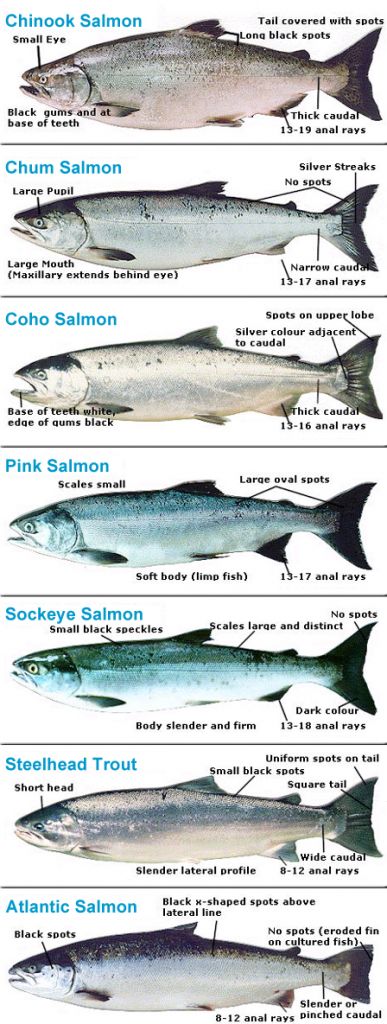Pacific Salmon Identification Information

Pacific Salmon Identification Information This chart is intended to help anglers identify salmon by species. however, it is the angler’s responsibility to be able to positively identify the species at any point in its life cycle. In order to provide salmon & steelhead fishing opportunities, wdfw and the tribes have marked salmon & steelhead by clipping the adipose fin (a small fatty fin directly behind the dorsal fin).

Pacific Salmon Identification Information It’s undeniable that salmon are one of the most important species in the puget sound watershed, but do you know how to tell the difference between the five pacific species?. There are five (5) species of pacific salmon … the chinook (aka spring king tyee) salmon, the chum salmon, the coho salmon, the pink salmon & the sockeye salmon. While in the ocean they appear to have steel blue to blue green backs, silver sides, and a white belly with large oval spots covering their back, adipose fin and both lobes of the caudal fin. during the spawning phase pinks have dark backs with a pinkish wash and green blotches on their sides. Our complete overview of the five pacific salmon species, covering appearance, ecosystem roles, spawning preferences, economics and conservation status.

Pacific Salmon Identification Chart While in the ocean they appear to have steel blue to blue green backs, silver sides, and a white belly with large oval spots covering their back, adipose fin and both lobes of the caudal fin. during the spawning phase pinks have dark backs with a pinkish wash and green blotches on their sides. Our complete overview of the five pacific salmon species, covering appearance, ecosystem roles, spawning preferences, economics and conservation status. Salmon live the majority of their lives in the ocean (marine phase). when salmon are ready to spawn and return to the fresh water they begin to make some dramatic transitions in their shape and color. in this phase, males and females both uniquely change in dramatic fashion. Note that the map below—a composite of the distribution maps for seven species of oncorhynchus —shows current and limited distribution as well as historic presence, effectively outlining the footprint of salmon throughout the north pacific. Learn to identify all 5 types of pacific salmon during ocean and spawning phases. expert guide with firsthand observations from an experienced alaska fishing captain. Learn about wild pacific salmon, as well as the threats this species faces, what wwf is doing to conserve its future, and how you can help.
Comments are closed.